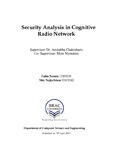| dc.contributor.advisor | Chakrabarty, Dr. Amitabha | |
| dc.contributor.advisor | Mostakim, Moin | |
| dc.contributor.author | Nasnin, Fahia | |
| dc.contributor.author | Islam, Najia | |
| dc.date.accessioned | 2017-05-11T07:03:21Z | |
| dc.date.available | 2017-05-11T07:03:21Z | |
| dc.date.copyright | 2017 | |
| dc.date.issued | 4/18/2017 | |
| dc.identifier.other | ID 13101138 | |
| dc.identifier.other | ID 13101142 | |
| dc.identifier.uri | http://hdl.handle.net/10361/8118 | |
| dc.description | Cataloged from PDF version of thesis report. | |
| dc.description | Includes bibliographical references (page 39-40). | |
| dc.description | This thesis report is submitted in partial fulfillment of the requirements for the degree of Bachelor of Science in Computer Science and Engineering, 2017. | en_US |
| dc.description.abstract | In wireless communication system Cognitive Radio(CR) is a structure that can gives an intelligent privileges to communicate over internet. Cognitive Radio(CR) intel- ligently allows user to use free spectrum. It is dynamically configured and it allows more user in wireless network. IEEE 802.22 standard cognitive radio (CR) was de- veloped first. Due to spectrum sensing, sharing, mobility there is a issue in security. Ensuring security and using spectrum efficiently is challenging. In this paper, the se- curity threats of cognitive radio network are briefly discussed. After explaining some of possible attack, we have emphasized on Primary user emulation attack(PUEA). With the existing system model the probability of false alarm and miss detection has been studied. MATLAB R2010a tool has been used to analyze the model. This pa- per we have shown Neyman-Pearson Criterion to detect PUEA and a for different malicious users status to create false alarm and miss detection | en_US |
| dc.description.statementofresponsibility | Fahia Nasnin | |
| dc.description.statementofresponsibility | Najia Islam | |
| dc.format.extent | 40 pages | |
| dc.language.iso | en | en_US |
| dc.publisher | BRAC University | en_US |
| dc.rights | BRAC University thesis are protected by copyright. They may be viewed from this source for any purpose, but reproduction or distribution in any format is prohibited without written permission. | |
| dc.subject | Security | en_US |
| dc.subject | Cognitive radio network | en_US |
| dc.title | Security analysis in cognitive radio network | en_US |
| dc.type | Thesis | en_US |
| dc.contributor.department | Department of Computer Science and Engineering, BRAC University | |
| dc.description.degree | B. Computer Science and Engineering | |

